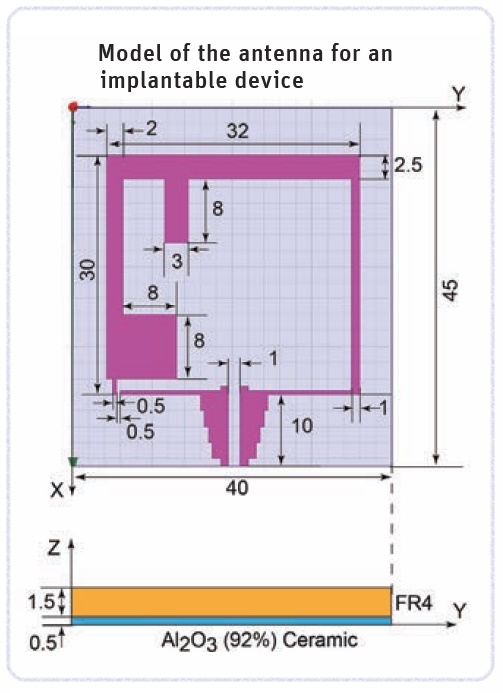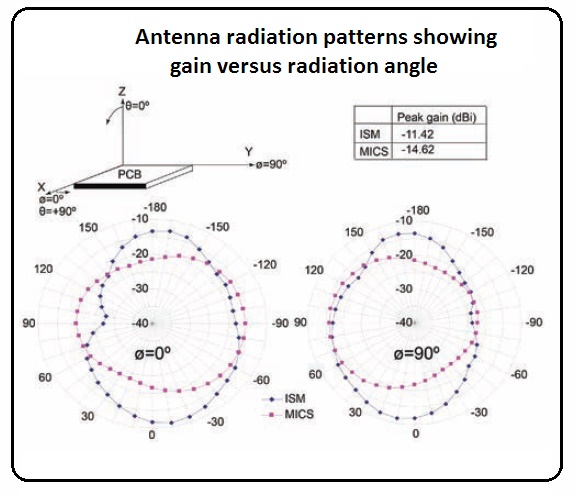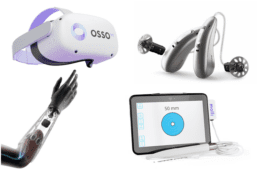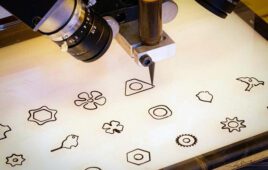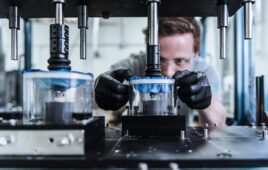The Internet of Things for healthcare requires that antennas in implantable medical devices operate safely within the human body as well as over longer distances than before and at more than one frequency. These devices must also be reliable in the wide range of body types. To consider many factors, Cambridge Consultants uses ANSYS software to model body variations and simulate antenna performance.
Arun Venkatasubramanian, Associate Director, Cambridge Consultants,
Boston, Mass.
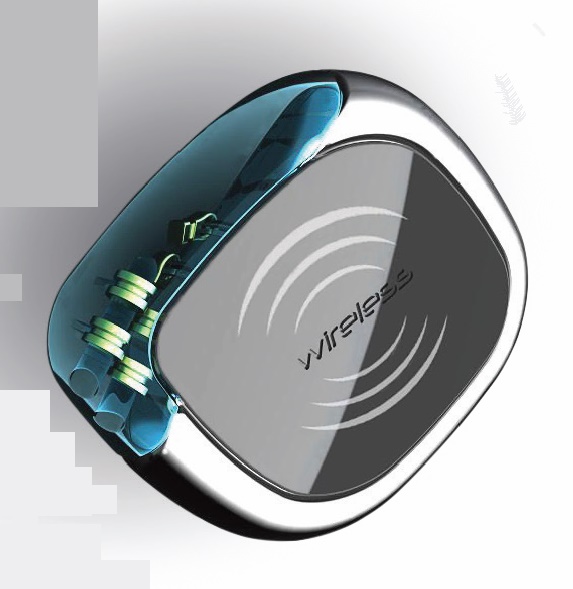
The artist rendition is of a neurostimulation implant for chronic back pain and one application for the new antenna design.
Wireless technology adds a new dimension to medical implants that allows remote monitoring and improved treatment. However, to design a su
ccessful wireless implant, designers must address many different use cases and regulatory requirements. Each poses its own challenges.
Typically, a smart medical implant must communicate wirelessly with an external handheld device in at least three different environments:
- The operating room, where the implant is programmed before being inserted into the patient.
- The medical office, where a clinician carries out follow-up monitoring by wirelessly communicating with the implant using an external programming device.
- The home, often using a bedside wireless box that talks to the implant to immediately relay diagnostic information, as well as alarm conditions, to the doctor or caregiver.
Body tissue affects wireless radio performance by reflecting and absorbing some of the signal, as well as affecting the antenna’s operating frequency and bandwidth. The patient’s body type has a significant effect on the communication distance between the implant and the external device.
In recent years, Bluetooth links to smartphones have emerged as a popular choice for connectivity. Implantable-device manufacturers want to explore this option. Bluetooth operates at much higher frequencies than current wireless technologies used in medical devices, which means the body absorbs an even higher proportion of the Bluetooth signal, making the range problem even more difficult. The antenna may need tuning from time to time to accommodate changes in patient physiology – for example, if the patient gains or loses weight. Finally, regulatory bodies place stringent restrictions on the radiated power, the specific absorption rate, and the rate and amount of data that can be transmitted over the air.
Cambridge Consultants, a supplier of innovative product engineering and technology consulting, uses ANSYS simulation tools to overcome these challenges. Simulation lets engineers optimize the design of implanted device antennas to increase their range, let them operate at required frequencies, and validate their performance in advance for a wide range of body types.
Designing an implantable antenna
Our engineers recently designed a small antenna that works on both the 402 to 405 MHz (medical implant communications service [MICS]) and 2.4 to 2.5 GHz (industrial, scientific and medical or ISM) bands, and enables wireless communication at a range of two meters or more so that it can be used outside the sterile zone in the operating room. The capacitive nature of human tissue, along with the large capacitive reactance of traditional electric dipole antennas, produces a residual negative reactance that must be compensated with a lumped inductive load to match the microchip impedance. This called for a relatively new approach to antenna design – a compound field antenna that uses magnetic-loop radiators and co-located electric-field radiators. This approach provides an intrinsic inductive reactance that lets engineers match impedance to the implanted electronics more easily, and better support miniaturization and biocompatibility.

Left: The chart plots a frequency response of an antenna in an MICS band for different amounts of body fat.
Right: The chart plots a frequency response of an antenna in an IMS band for different amounts of body fat.
Fat, muscle, various types of bone, skin, and blood all have different dielectric properties. The dielectric properties of the surrounding tissue strongly affect the behavior of the antenna, for example, lowering the resonant frequency compared with the free-space performance of an antenna with the same dimensions.
But the effect of the body on the antenna differs depending on the location of the antenna in the body and on the patient’s body type. Nearly all engineers
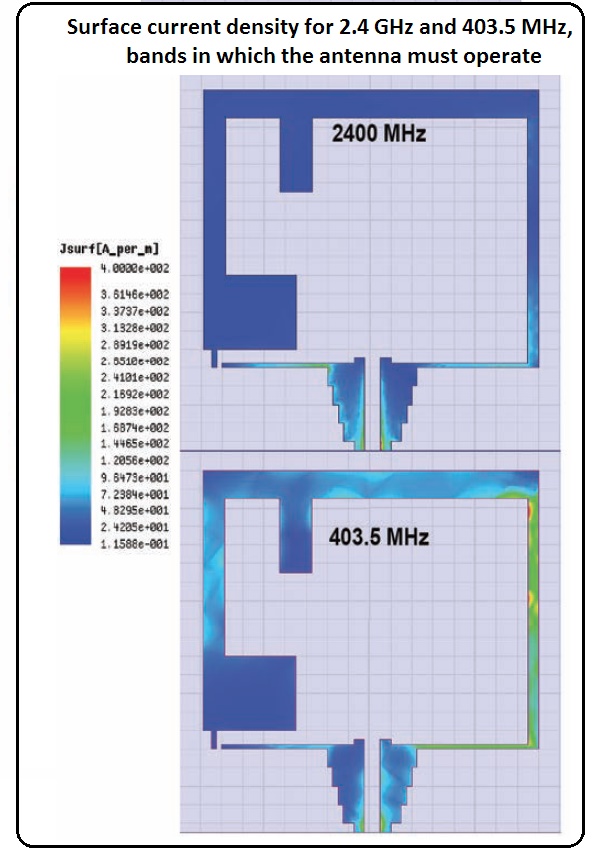
The 402 to 405-MHz band is for medical implant communications service while the 2.4 to 2.5 GHz band is for industrial, scientific, and medical tasks.,
who design antennas for implantable devices perform electromagnetic simulation using a human-body model with elements that match the relative permittivity and conductivity of various body materials such as skin, fat, compact bone, spongy bone, muscle, and blood. The problem with many of these models is that they are difficult to change to match different body types. So engineers usually optimize the antenna for an average body type, which often leads to antenna-performance issues when the device is implanted into a patient with an atypical body.
Operating in two frequency bands
Nearly all modern wireless implants operate in the MICS band, but recently manufacturers are interested in developing devices that can operate in the ISM band. The ISM band can let devices communicate with smartphones, eliminating the need for a custom external communications device, making it possible to take advantage of the powerful capabilities of smartphone technology. Our team designed a new antenna from the ground up to work with both bands.
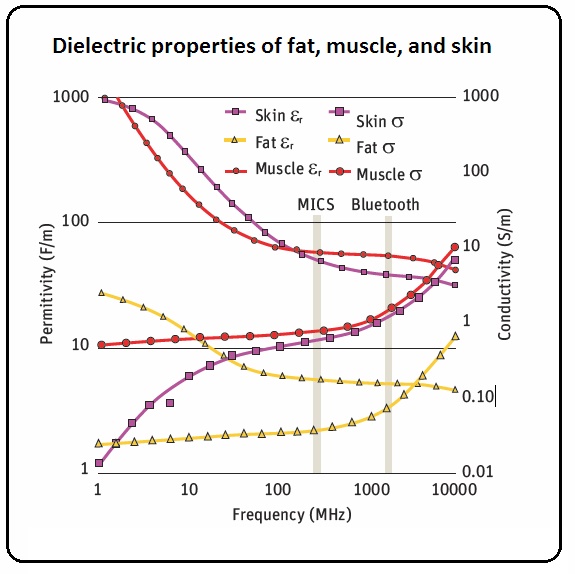
The antennas will help improve healthcare by enabling the design of a new generation of medical devices that operate at a longer range and collect patient data for many body types.
The dual band, compound-antenna topology was simulated on a 1.5 mm FR4 (glass-reinforced, epoxy laminate, printed-circuit board) substrate with a 0.5 mm Al2O3 (aluminum oxide) substrate backing. The fat thickness in the HFSS (High Frequency Structural Simulation) human body model was varied between 1.5 mm and 5.5 mm in 0.5 mm steps. The antenna-return loss was optimized for both frequency bands. The surface current density for the antenna structure was plotted for excitations at the two center design frequencies. The antenna demonstrated a peak gain of –11.42 dBi in the ISM band and –14.62 dBi in the MICS band.
The coupled electric and magnetic dipole antenna provides sufficient gain, radiation efficiency and broadband response in both the 402 to 405 MHz and 2.4 to 2.5 GHz bands in a wide range of body types and dimensions to let the external communications component operate outside the sterilized zone. The single planar structure is
easily fabricated on a single 40 x 45-mm bilayer substrate (FR4/Al2O3). This antenna and others developed using similar simulation methods will help improve healthcare by enabling the design of a new generation of medical devices that operate at a longer range and collect patient data for many body types.
Modern implantable devices are complex and require engineers to balance performance, safety, reliability, cost, and time-to-market constraints. Developing a scalable human body model helped our team perform regression analysis on antenna designs right from the beginning of the design activity. This halves the number of iterations needed and reduces the design time by 25%.
The company has been able to increase the radio range for its novel antenna designs by 45% compared with traditional PIFA and loop antennas. Field data shows good correlation between the simulated and finished product results.
How to model body fat, skin, and muscle
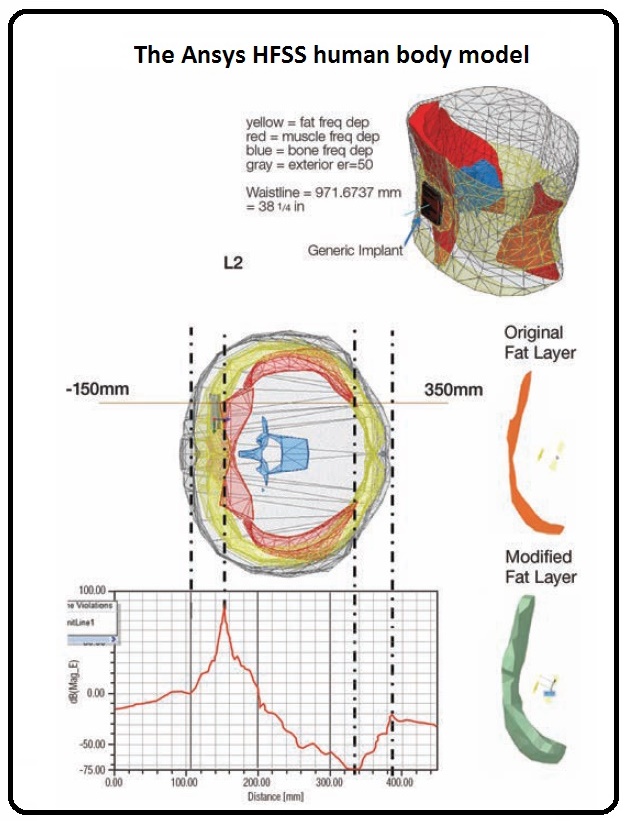
The ANSYS HFSS human 3D body model, a human torso in this case ( upper right) was modified with ANSYS SpaceClaim Direct Modeler to represent different body types. The circular image (middle) is a cross section of the torso showing spine (blue) and muscle in red. ANSYS SpaceClaim makes it easy to change an object’s geometry as will be necessary for different body types..
Our team at Cambridge Consultants designs antennas by simulating their performance using ANSYS High Frequency Structural Simulator (HFSS) electromagnetic software with a human body model to represent the environment in which the antenna will work.
We use ANSYS SpaceClaim Direct Modeler software to rapidly modify the HFSS human body model to represent changes in body morphology – heavy patient, light patient, or someone in between. This is necessary to develop an antenna that unaffected to changes in body morphology.
SpaceClaim lets users create, edit, and repair geometry without worrying about underlying technology, thereby shortening the time to analysis. Users can pull, move, fill and combine features of a model to, for example, create rounds, move a feature to another face or change the size of a face. If they prefer, users can enter particular body dimensions.
This capability let our team alter the thickness of fat layers, and surrounding skin and muscle contours to scale a single body model. Such advanced capability is not yet available in other simulation programs. Rather than a single scalable body model, competitive programs provide in a family of body types.

